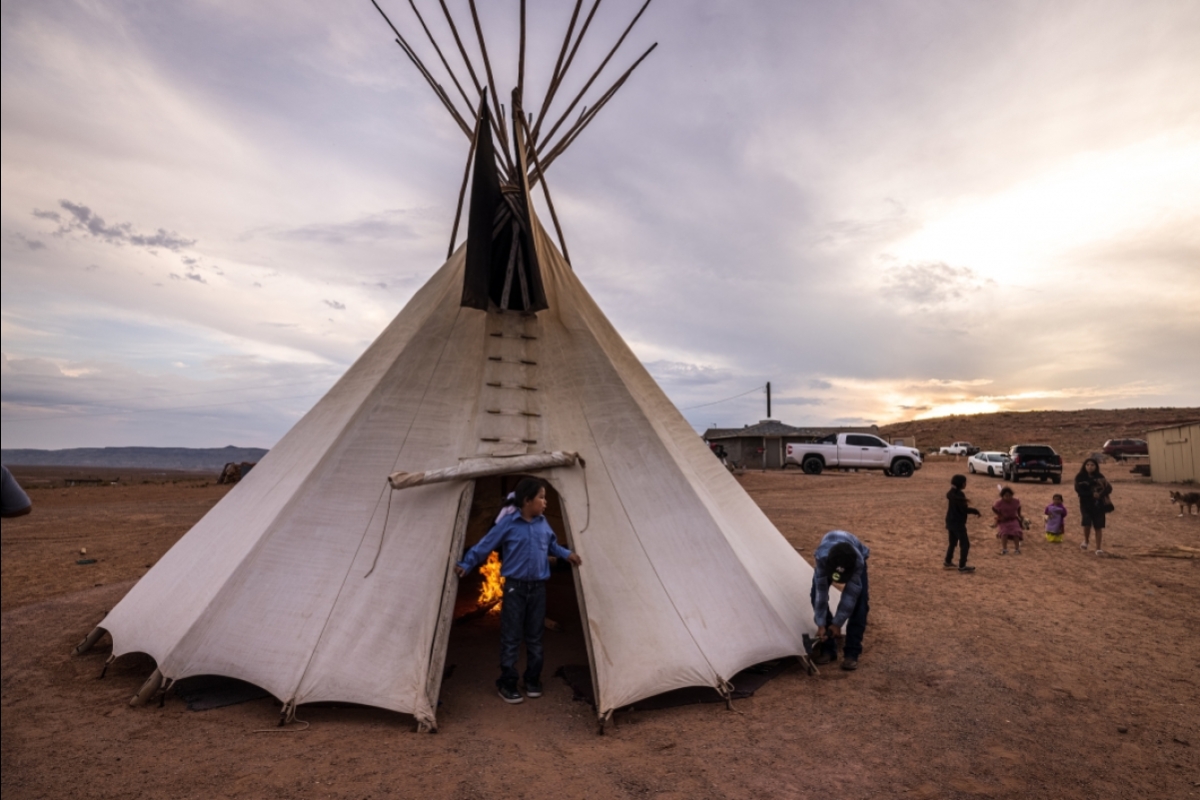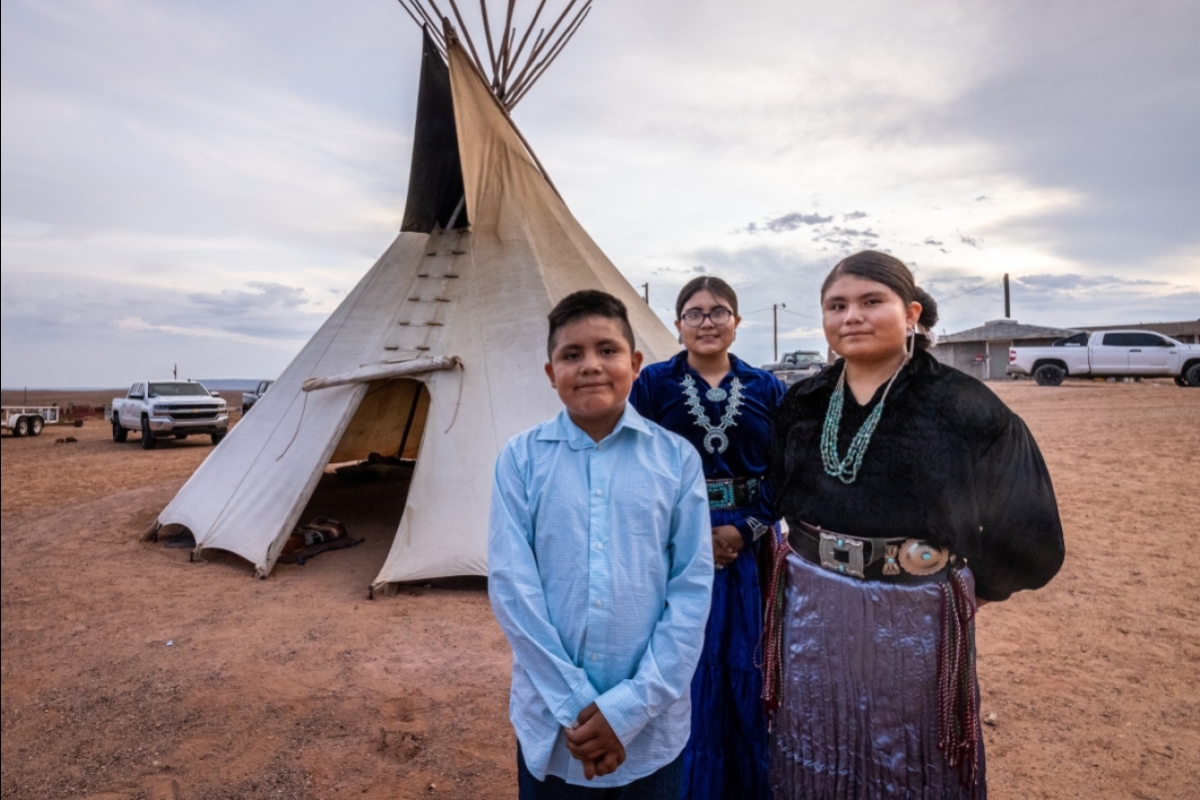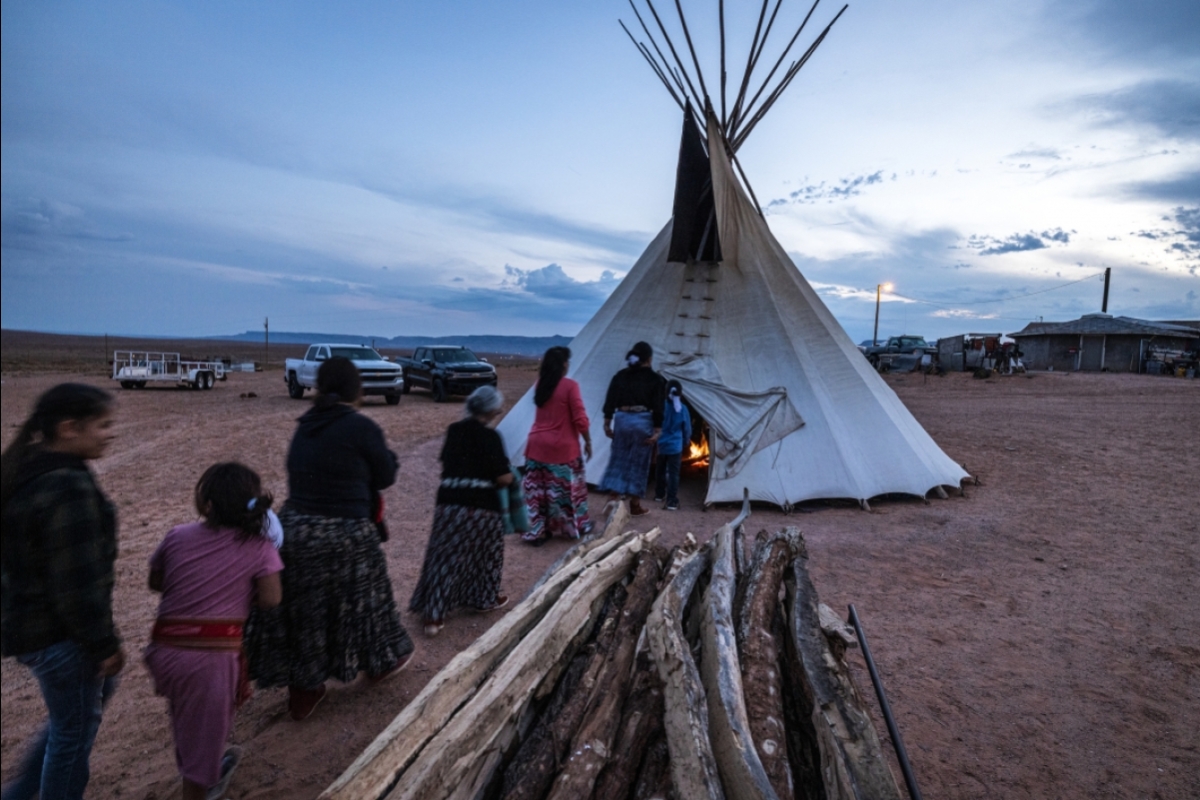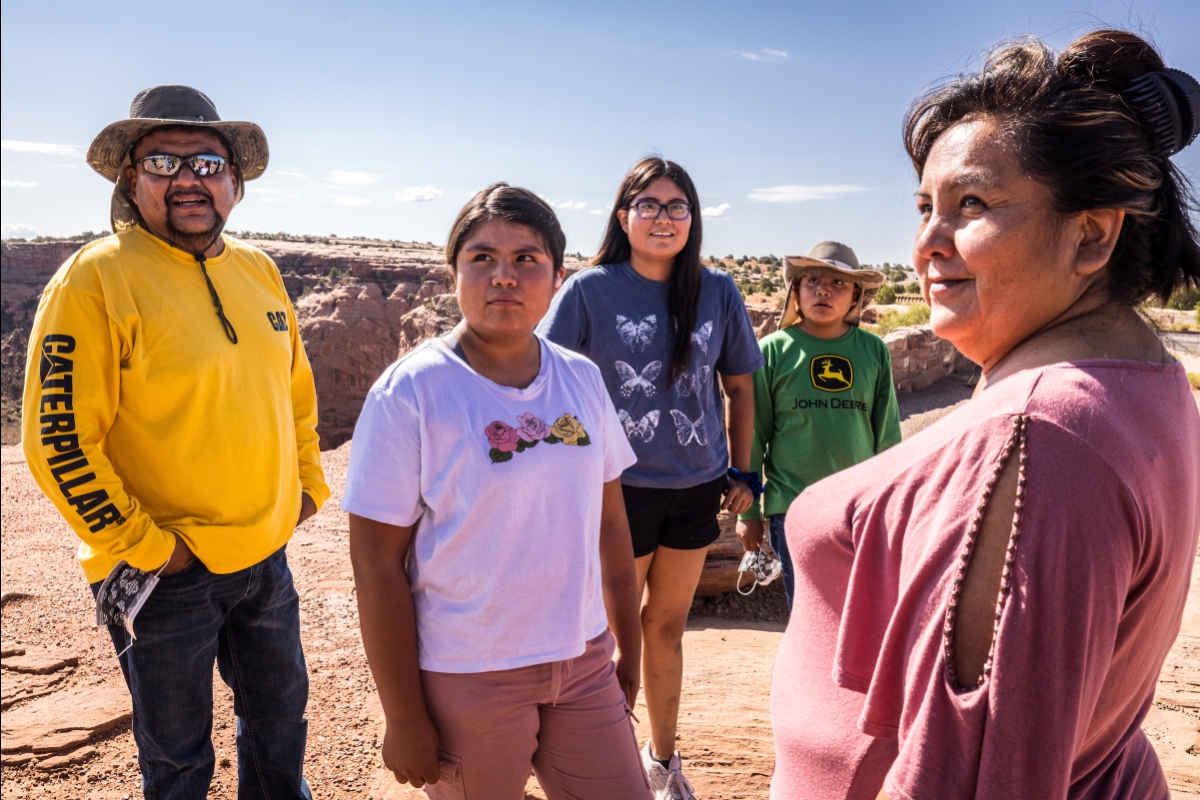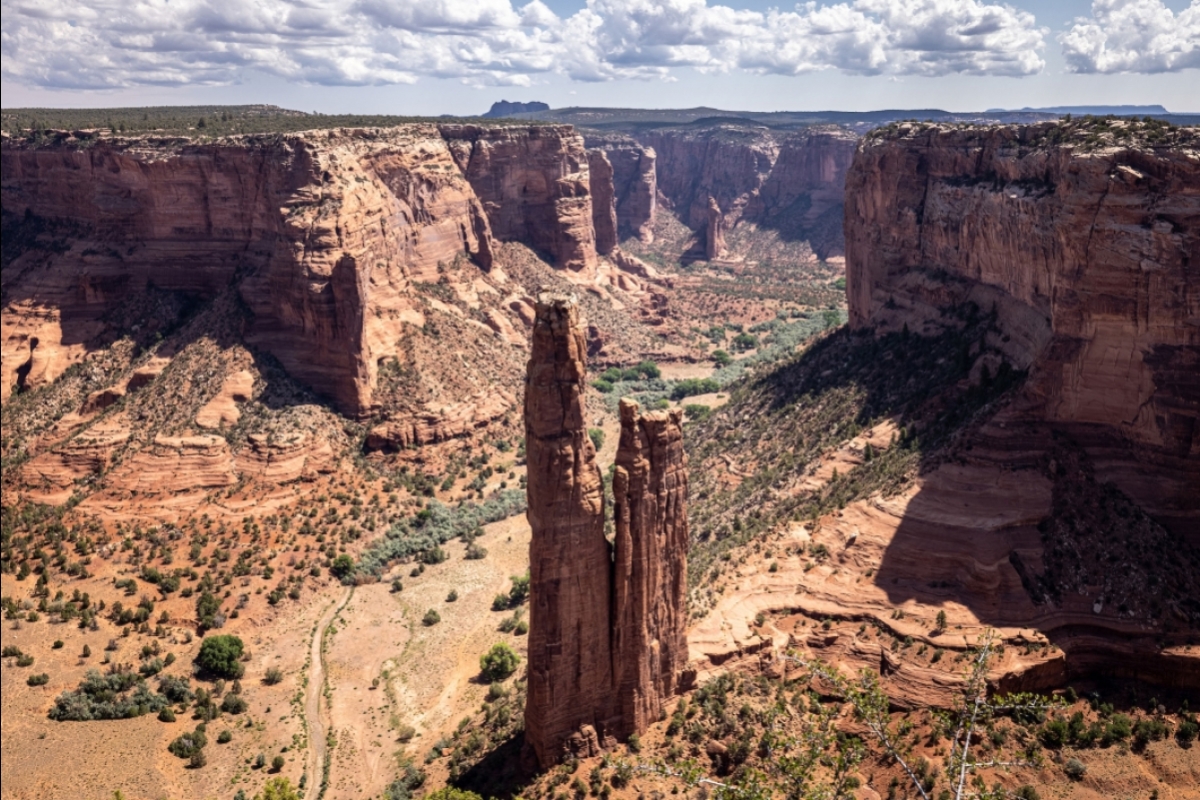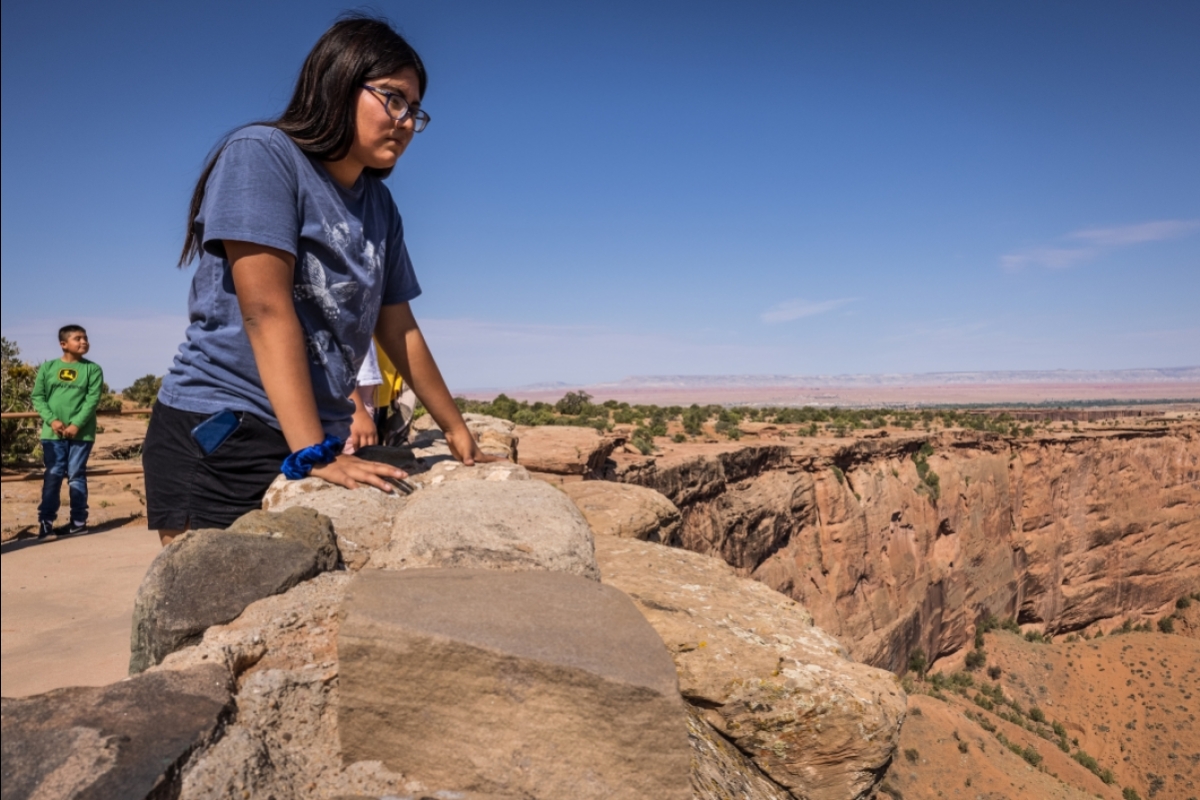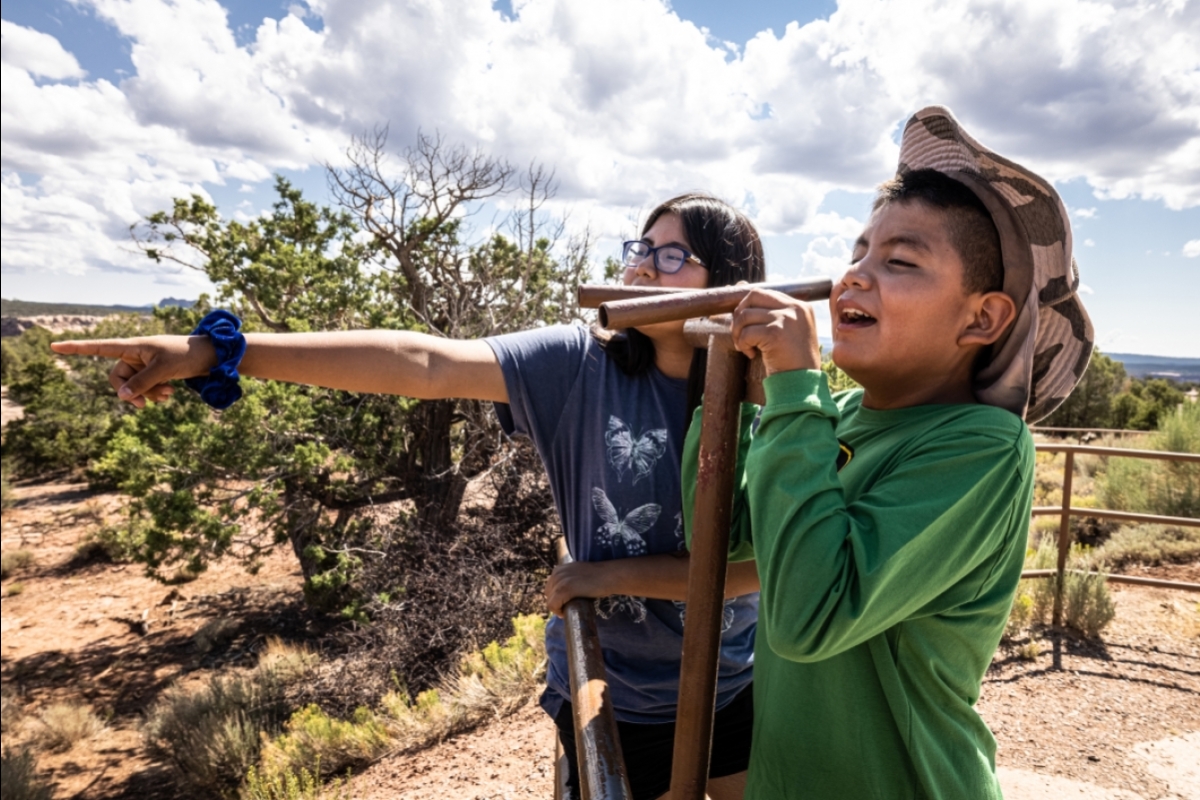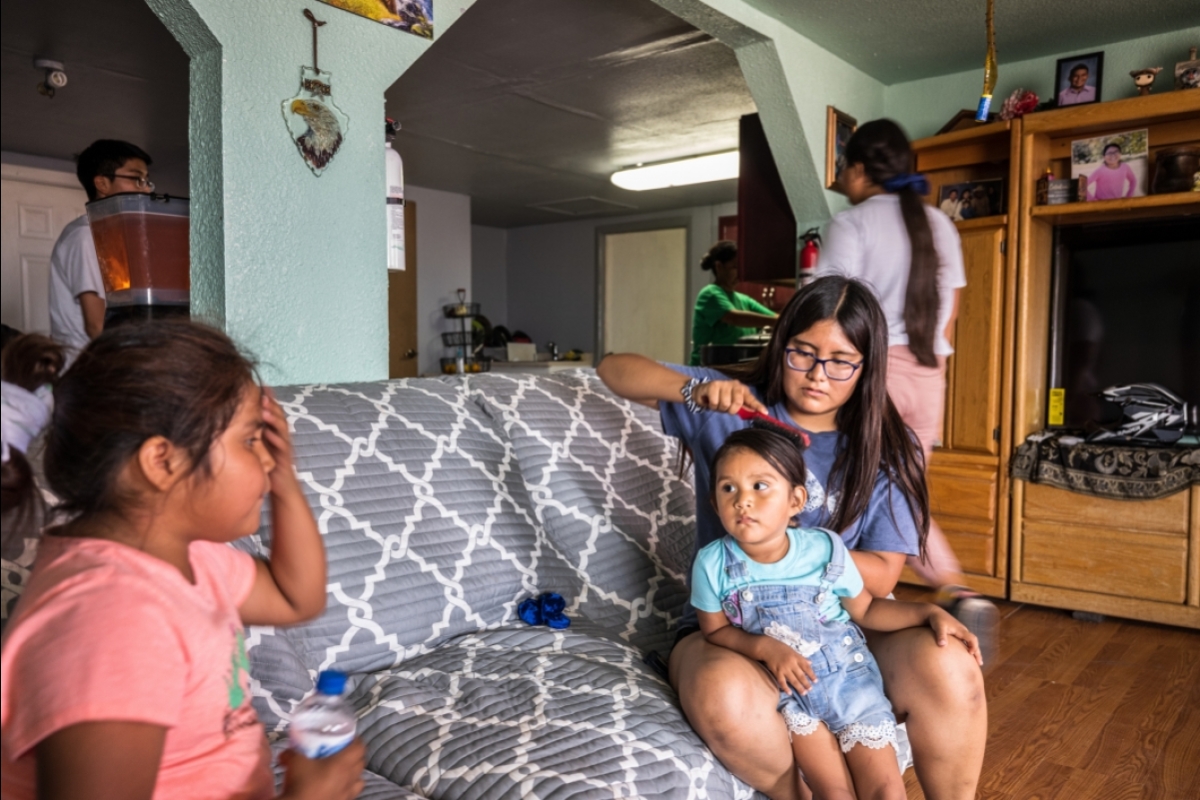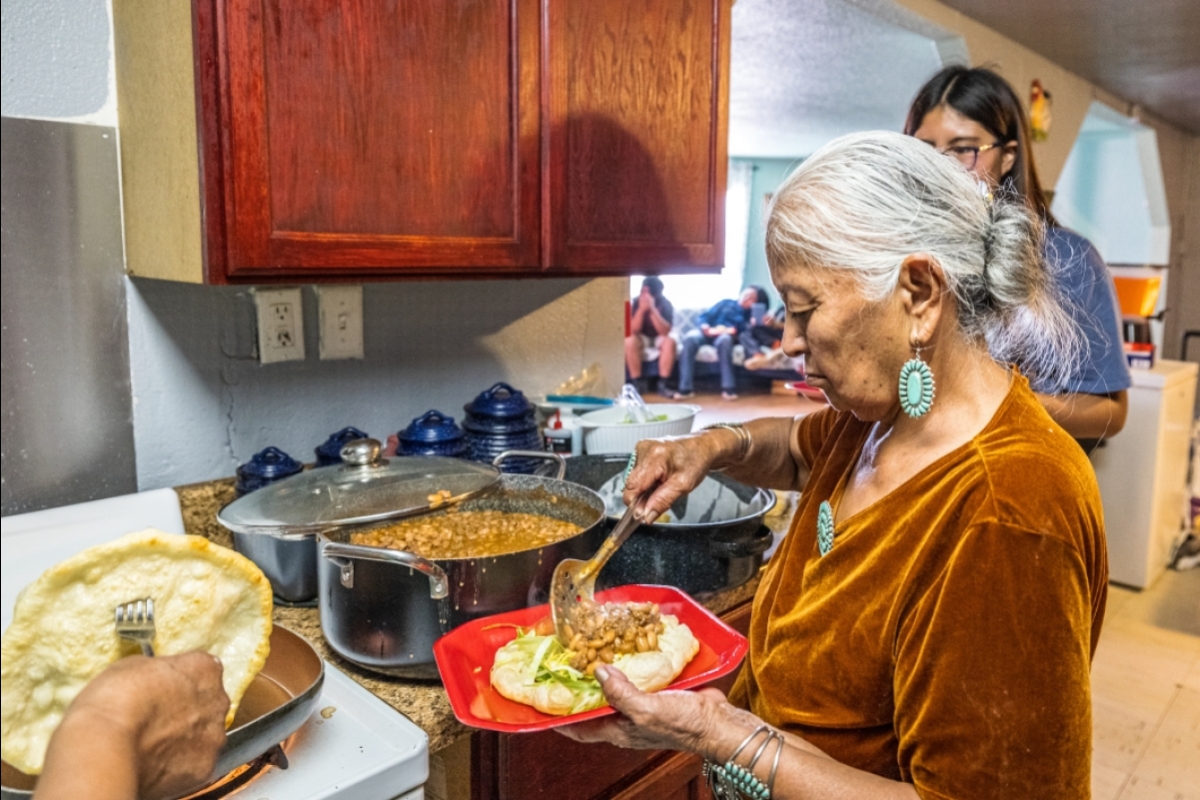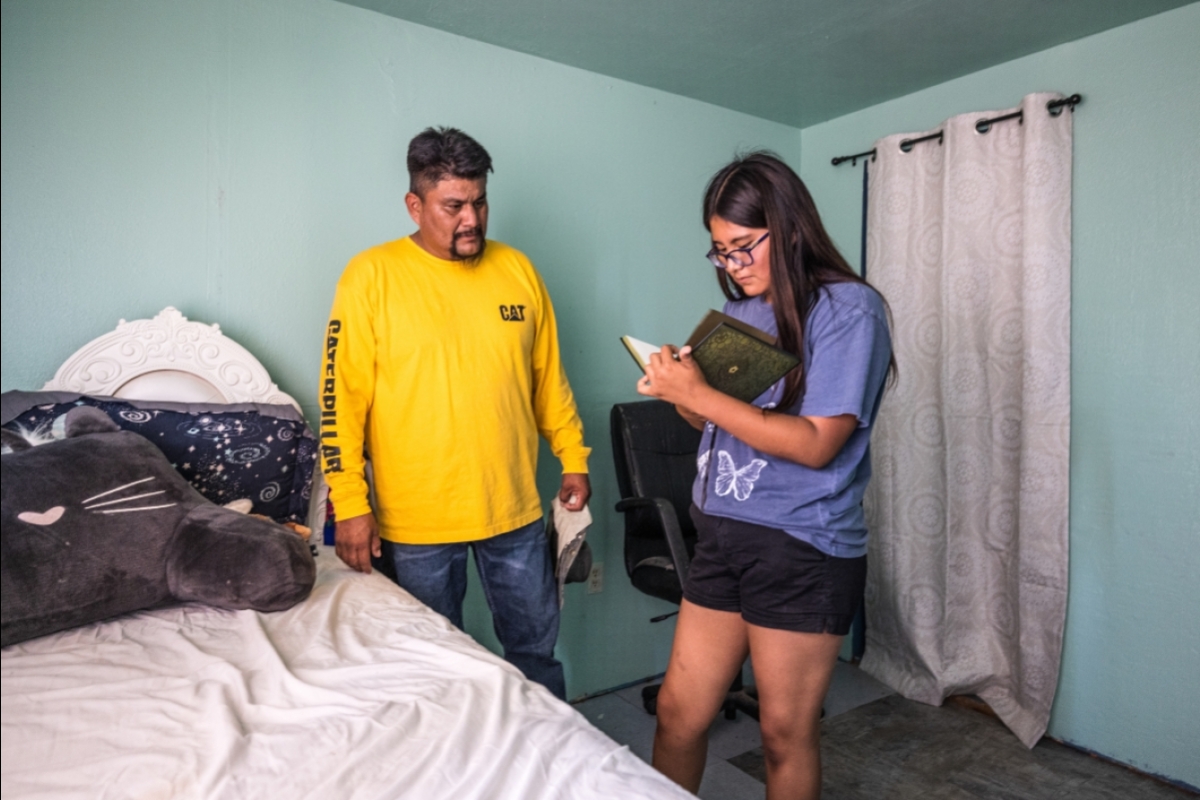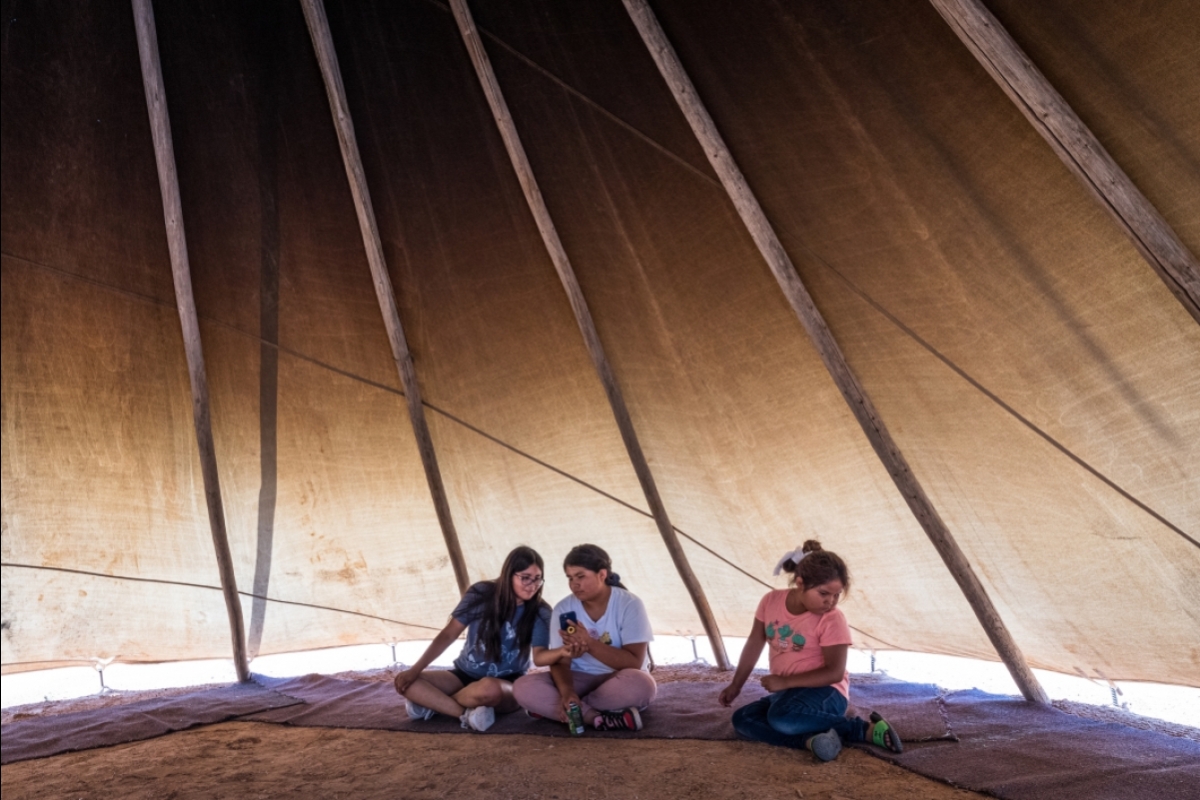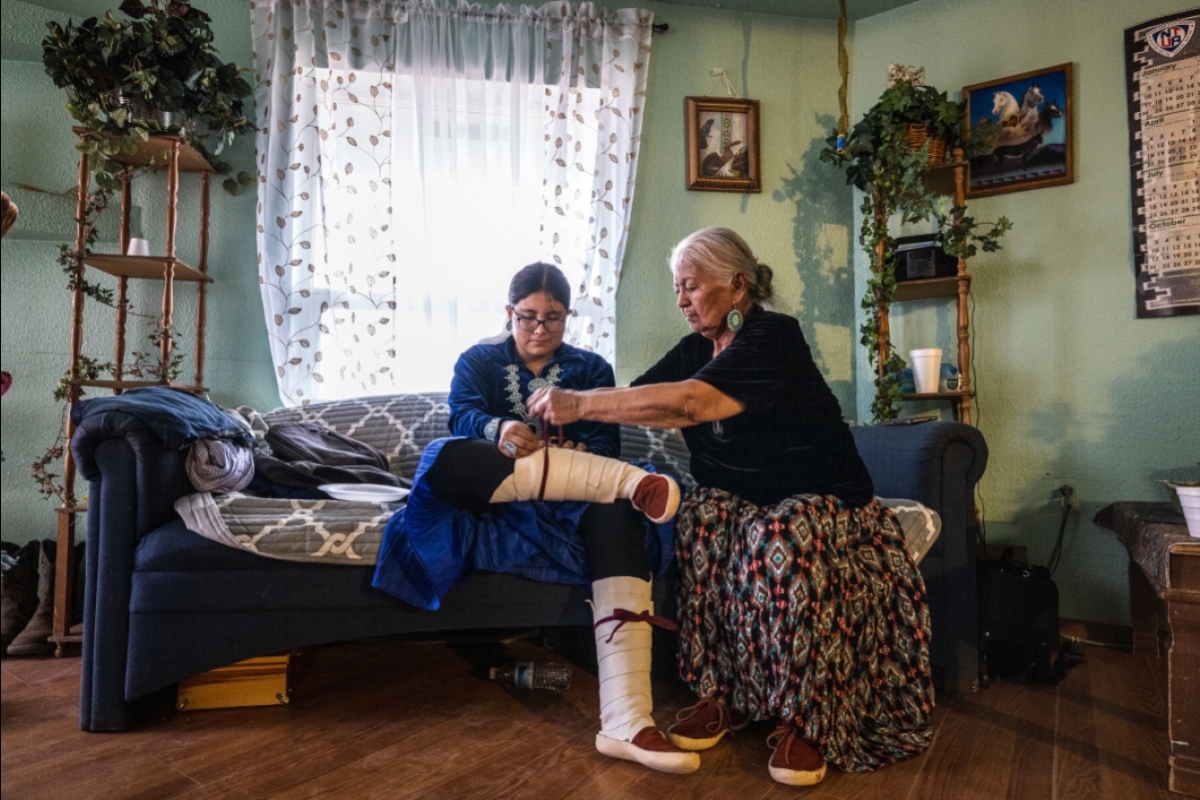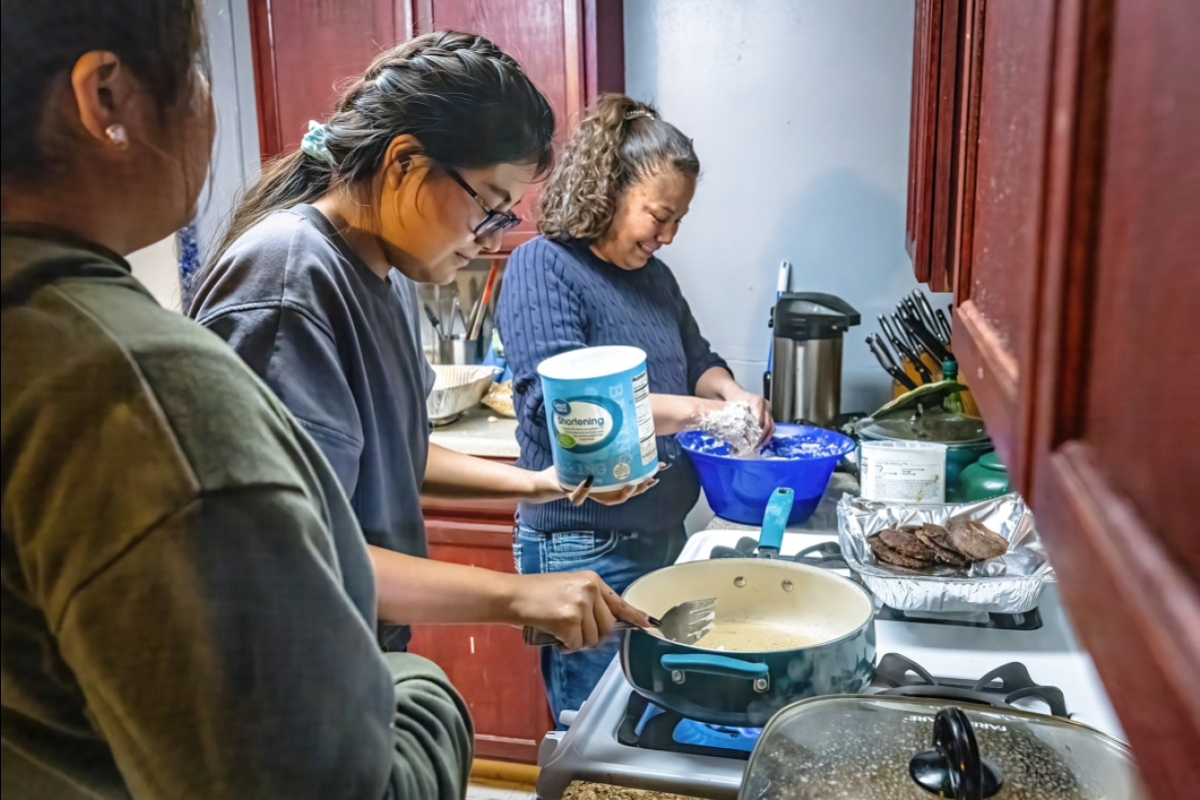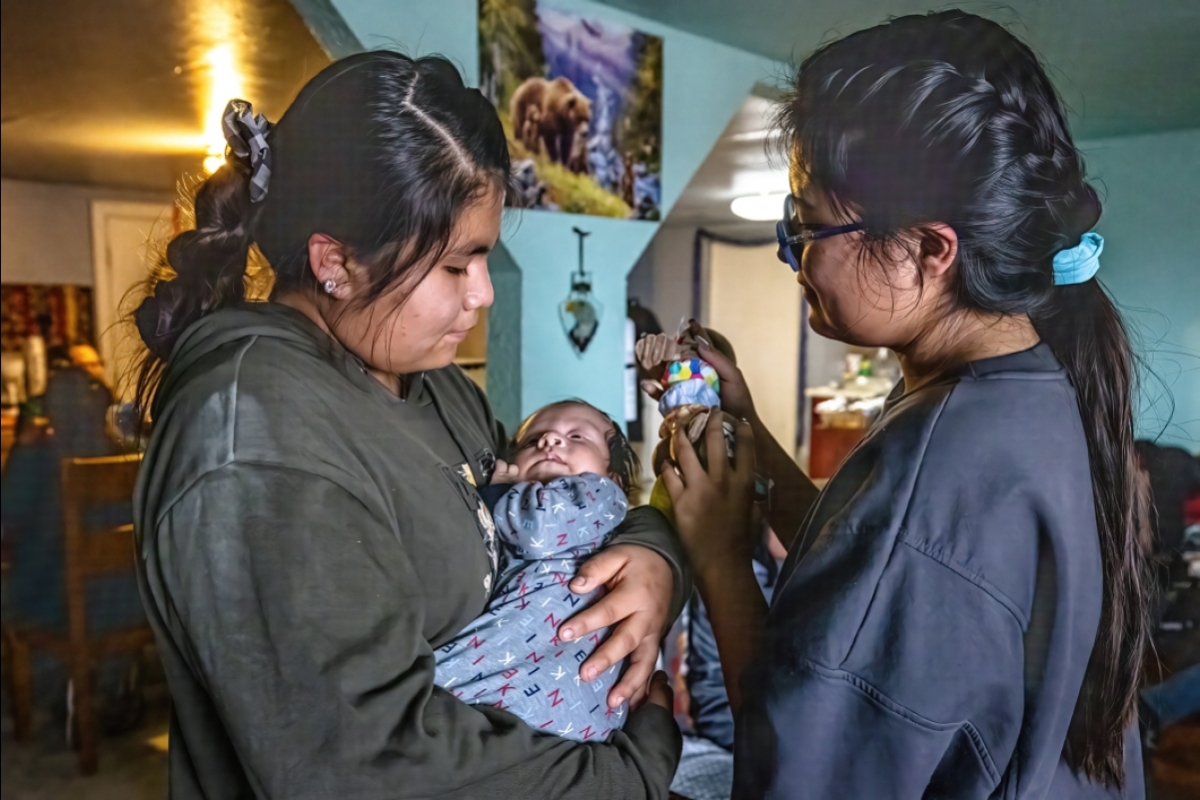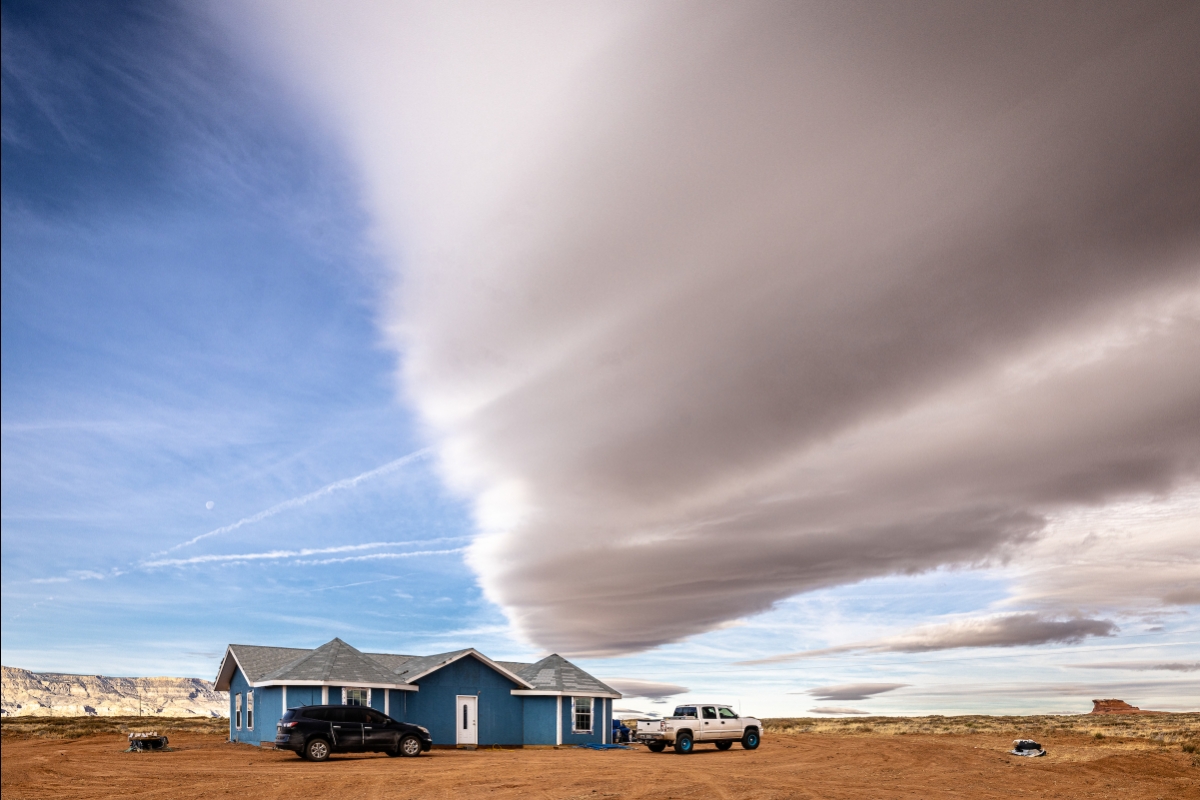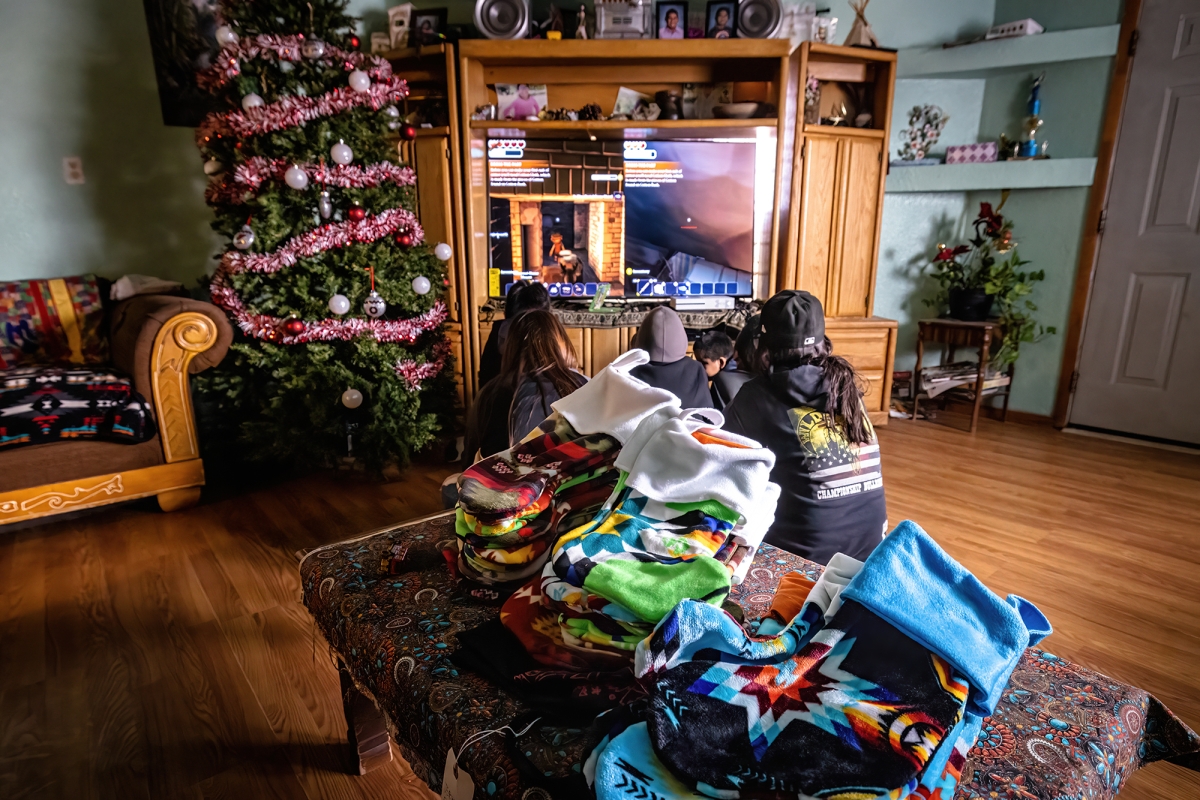A student’s journey toward the stars
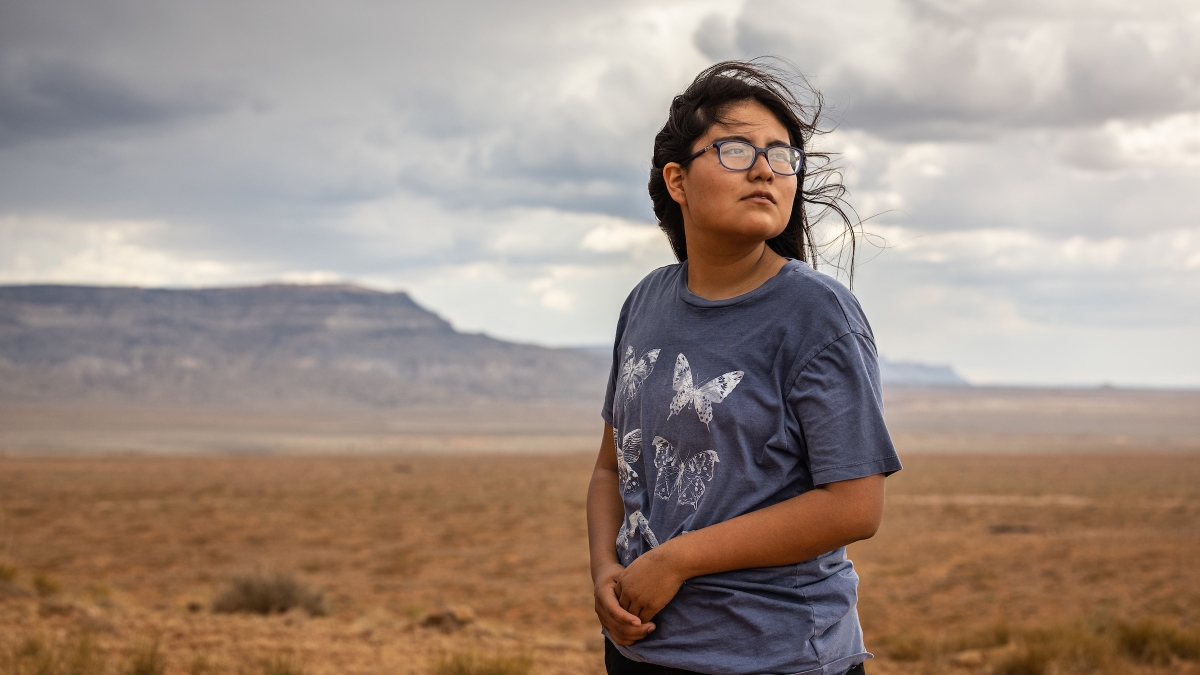
Kiera Charley looks at darkening clouds on a butte at the Charley land outside Many Farms, Arizona, on July 19, 2021. Photo by Charlie Leight/ASU News
Editor’s note: This story is featured in the 2022 year in review.
Editor's note: ASU News reporter Marshall Terrill, photographer Charlie Leight and videographer Ken Fagan spent the past school year following Kiera Charley's journey through her first year at Arizona State University — from visiting her home in northern Arizona as she said goodbye to loved ones to making new friends. Along the way, we spoke with relatives, former classmates and teachers, ASU academics and staff members to gain more insight into Kiera's transition from the reservation to studying at a major university. This story is told with the Charley family's permission.
It's dusk, and smoke from an oak wood fire wafts from a tipi and disappears into the stars over the reservation.
Inside a house nearby, Kiera Charley is wearing a traditional Navajo blouse and silver and turquoise jewelry, preparing to walk out to the tipiThe Charleys are members of the Native American Church and utilize tipis rather than hogans for religious ceremonies. where she will join her family and supporters. They are about to begin a sacred ceremony, which will last all night and end at sunrise. They will sing songs and pray throughout the night to ask the holy people for help guiding and protecting Kiera as she prepares for her trip to Tempe.
It's not a quiet scene on the mesa of Many Farms, just outside Chinle, Arizona, on the Navajo Nation.
A drum beats steadily.
Dogs bark.
Children are laughing.
Adults are conversing.
The fire crackles.
It's a gathering of generations. Their purpose on this mid-August night is to bless Kiera before she heads to Arizona State University to pursue a degree in astrophysics.
As she prepares to leave her family's homeland, the ceremony — commonly practiced among the Navajo — will bless and protect her in the outside world as she ends one academic journey and starts another.
Kiera is a star student — a Flinn Scholar, starting college at 16 — but for her and other Native American students, intellect alone doesn't conquer all the barriers they have to face to complete college.
Historically, statistically and anecdotally, Native Americans find it more difficult to earn a degree. According to the National Center for Education Statistics, as of 2019This is the NCES’s latest data and was provided by ASU’s Labriola National American Indian Data Center., approximately 133,000 Native Americans attend college each year in the U.S., making up about 0.06%According to the 2020 census, those who identified as American Indian and Alaska Native, either solely or in combination with another ethnicity, made up 2.9% of the total U.S. population. of the nation's college student body. When compared with other ethnicities — white (51.5% of U.S. college students), Hispanic (19%), Black (12%) and Asian/Pacific Islander (6.6%) — it's not even close.
The reasons are many and varied: The academic calendar does not correspond with the calendars of their home communities. Their ways can be different from mainstream society. That extends to how they view spirituality and religion; how they acquire knowledge (Navajos, for example, are mostly visual and auditory learners, according to Kiera's mother, Erika Begay); how they interact with one another; their reciprocal relationship with nature and the environment; and how many are desperately trying to maintain their traditional language and culture.
Breaking away from their family and the reservation is hard; homesickness is a major issue. Native Americans can have stronger ties to their land; it's often where their ancestors have lived for hundreds and hundreds of years. There are also the ties to family and their community. When those students step off the reservations, traditions can become lost in a world that revolves around Thanksgiving, Christmas, spring break and the Fourth of July. They're going to leave behind food that can be difficult to find elsewhere — like a butchered sheep and blue corn mush. Even the hamburger is different.
In short, almost everything.
ASU News tagged along with Kiera Charley as she experienced her first school year at ASU, witnessing her transition from the reservation to a big campus in a big city far from home, and cheering along as she found her footing and her friends on campus.
This is her story, but it's also the story of thousands of Native American students who enter college life each year: their challenges, their triumphs and how higher education — and ASU in particular — is changing to better serve them.
The backstory
For Erika Begay and her husband, Jeroy Charley, sending their daughter Kiera off to boarding school a few hours away was a gut-wrenching decision. It gave Kiera a better education, but she lost a chunk of her childhood.
"As a mother, that was such a hard decision because I felt guilty for not being there for her every day," Erika said. "But I knew the price of her education was invaluable."
In a way, it has become a family tradition.
Erika's mother, Lorraine, did it; then it came time for Erika to do the same with her child.
For most students living on the extensive Navajo Nation, attending a boarding school is one of the few ways to pursue a better education. It's not like the wider culture, where oftentimes even college students will live at home until they've earned their degree.
The distances on the Navajo reservation are vast; it's the biggest Native American reservation in the country. Commuting to college is difficult. If scholarships or some sort of assistance isn't attained, getting a higher education degree is almost impossible.
"Research tells us that there are four primary challenges for Indigenous students in higher education: not enough financial resources, not enough role models to guide students, poor academic preparation and cultural incongruities," said Bryan McKinley Jones Brayboy, President's Professor, director of the Center for Indian Education and ASU's senior adviser to the president on American Indian affairs.
"In Kiera's case, she has an amazing fellowship, parents who went to college and a fantastic array of support from Indigenous faculty (and others) at ASU. She is clearly gifted academically and works hard. She offers insight into the power of supports — both in and outside of the institution. She is — in so many ways — a force of nature, focused on her future and the future of others. And she highlights what is possible," Brayboy said.
That possibility was sparked by her maternal grandmother, Lorraine Begay, whose parents were migrant farmworkers who spoke strictly Navajo and "came from nothing." Lorraine's childhood home in Coyote Springs, Arizona, didn't have television, electricity, plumbing or running water. She was sent away to a boarding school at age 4 and later received her bachelor's degree in business administration from Northern Arizona University. When she became a mother, she instilled in her children that an education was a must.
"My parents were very involved in my schooling and encouraged us to find a career path that would make us happy," Erika said. "The notion of us going to college was always there."
Erika eventually earned two degrees — a bachelor's degree in elementary education and a master's degree in early childhood education from Northern Arizona University. Lorraine and Erika are hoping that Kiera lands higher.
"The first time I held Kiera in my arms, I was in the birthing room at the hospital. Her little hand held onto my finger, and I told her she was going to be the first doctor in our family because that's what I expected of her," said Lorraine Begay, who worked in education, the health care industry and several Native American social organizations throughout her career. "I have high expectations for all of my children and grandchildren. I'm a firm believer that an education can bring so many opportunities and help you get over life's hurdles."
In order for all of this to work, Erika and Jeroy kept two residences and enlisted relatives pitching in to help out. Erika works and has an apartment in Tohaali, New Mexico, about an hour from Kiera's boarding school in Farmington. Jeroy works around the state at various construction sites while their other two kids — Ciera, 13, and Jeryn, 11 — attend a Bureau of Indian Education school in Tohaali. On weekends, they drive home to Many Farms, where they own the land and live close to other family, including Jeroy's mother.
On Fridays, Kiera's school bus would take her back to Many Farms, a two-and-a-half-hour commute. On Sunday afternoons, she would head back to Farmington, another long bus ride. Kiera did this for four years.
It's a lot of logistics to work out, and not a situation that many could sustain. It helps that Kiera's parents know what academic guidance and discipline to provide, having been through college themselves. But it's still a nonstop whirlwind.
It worked for the Charleys, however, through a lot of family effort and caring instructors at the prep school where Kiera attended.
Those who studied or worked with her at the tribal-sanctioned Navajo Preparatory School say she was exceptional, disciplined and devoted to her studies.
'"Kiera has a unique personality in that she's well-rounded, very nice and likes to try new things. Even if she doesn't know something, she does her best to do better," said Keona Hosteen, who was a year ahead of Kiera at Navajo Prep and just finished her second year at Northern Arizona University. "She's also someone who pushes others to do better like an older sister would. She has a high expectation of herself, and that rubs off on others."
Yolanda Flores, Kiera's science teacher at Navajo Prep, would agree with that assessment.
"Kiera was a very active student who advocated for herself and was very inquisitive in class. She was a kid who would raise her hand and say, ‘Ms. Flores, I don't understand. Would you please explain that again?'" said Flores, who has taught since 2012 at Navajo Prep, which has a student body of about 260 students. "We want to develop students to become leaders now and into the future. I tell all of my kids success is not always a straight path and it's like a river. It can go left; it can go right. But whatever direction it takes you, make sure you go towards that dream."
Kiera's hard work paid off: She won a prestigious Flinn Scholarship, which helped her family out tremendously.
"If she didn't get the scholarship, it would have been a struggle to send her to college," Erika Begay said. "We told her that all of the colleges she was accepted to, she would have to accept the one that offered the most financial assistance. We were ecstatic to learn she was a Flinn Scholar recipient."
The Flinn Scholarship — valued at more than $130,000 — covers tuition, fees, room and board at one of Arizona's state universities, plus study abroad. In order to qualify, Arizona high school senior candidates must maintain a 3.5 GPA, rank in the top 5% of their graduating class, and participate and demonstrate leadership in a variety of extracurricular activities. Each year, the Flinn Foundation chooses about 20 recipients; in 2021, they chose those 20 out of a pool of almost 1,100 applications.
Kiera is the 10th Native American to receive a Flinn Scholarship; the first went to Shelly C. Lowe in 1992. Lowe, an enrolled member of the Navajo Nation from Ganado, Arizona, grew up about 50 miles from Kiera's home in Many Farms. She currently serves as the chair of the National Endowment of the Humanities, having been nominated by President Joe Biden and confirmed in February 2022. Before that, she worked as the executive director of the Harvard University Native American Program.
Lowe said she reached out to Kiera after learning she was a finalist for the Flinn Scholarship to help talk her through what to expect and how to prepare for the interview process, and to discuss her options for college as Kiera had also applied for admission to Harvard.
"I had a good idea where Kiera was coming from, that she was excited about the prospect of being a Flinn Scholar, but that she would also have many questions about the interview process and what it would be like to be a Flinn Scholar," said Lowe, who is currently working on her PhD in higher education with a focus on American Indian student success and services at the University of Arizona. "I also knew she would potentially face a number of stereotypes and assumptions as a Native American college-seeking student coming from a rural community on the Navajo reservation."
Lowe said Kiera is like many Native students who seek out higher education — she has the ability, the desire, the dedication, the commitment to succeed, and often a wide-ranging support system of family and community members, school affiliates, her tribe and even funding organizations like the Flinn Foundation — but too often, high-achieving Native students like Kiera end up at a college or university that fails to support their path to educational success. The institution just doesn't become part of the support system, Lowe said.
"Too many institutions buy into the stereotypes that perpetuate excuses about the lack of Native student success being based on ideas of cultural mismatch, which place the problem on the student," Lowe said. "I wanted to give Kiera confidence and strengthen her determination, while reassuring her she has someone to reach out to when she is confronted with struggles."
In addition to staying in touch through texts and phone calls, Lowe sent Kiera a Native-inspired throw blanket for her high school graduation. These acts of kindness have touched Kiera.
"Even though she's a very busy lady, I look at her as a mentor," Kiera said.
Lowe traveled a similar path 30 years ago. Now she sees herself as a part of the institutional support that will help Kiera succeed.
Although the Flinn Scholarship helped pay for Kiera's tuition at ASU, she — and other Native American students — still had other issues to overcome. But those awaited her in Tempe.
Traversing the topography
As the Charley family navigates the wind-swept high desert of the Navajo reservation in their blue Chevy SUV, they discuss Kiera's hard work, past successes and the challenges to come. It's approximately six hours from Many Farms to Tempe, but really, they're traversing worlds. By the time they leave the Flagstaff pines behind and begin the long descent to metro Phoenix, it's beginning to sink in for all of them.
For the family, Kiera's departure is beginning to hit home. For Kiera, the goal she has worked so hard to get to is drawing closer. And she's electrified.
"I'm both nervous and excited. … I'm nervous because I'm younger than the average college freshman," Kiera said. "But there's a sense of excitement knowing I'll be going out into the world by myself and having the opportunity to experience all of these new things over the next four years."
Kiera has arrived two weeks before the start of the fall semester to check into the residence hall at Barrett, The Honors College and attend SPIRIT, an early-start camp for incoming American Indian students to get a jump on the school year.
Hosted by ASU's American Indian Student Support Services (AISSS), the orientation program moves students into the dorms two weeks early in order to get acclimated to their new environment and make new friends in anticipation of often-experienced culture shock during what, for many students, is their first time away from home.
Laura Gonzales-Macias, interim director of AISSS, said the purpose of SPIRIT is to "create a successful environment for Indigenous students and to strengthen their confidence as well as foster a sense of belonging." That includes giving equal attention to students' intellectual, emotional, spiritual and physical well-being.
The program features several group activities and more than 30 presentations and workshops by Indigenous students, alumni, faculty and administrators from many ASU student-support units and student organizations. Participants also complete a one-week course designed to strengthen their sense of purpose and set them up for academic success by introducing resources and electronic tools such as MyASU, Canvas and GetSet. They also make meaningful connections with other Indigenous peers through culturally inspired activities.
It's part of the support structure that has helped ASU grow its cohort of Indigenous students. As of the fall 2021 semester, the university has nearly 3,800 self-identifiedThis number reflects students who self-identify as Native American. ASU's enrollment according to IPEDS — the data program for the National Center for Education Statistics that is commonly used to compare institutions — is lower, because if a student identifies as both Hispanic and Native American, the Hispanic category takes precedence and the student is counted only as Hispanic. In addition, non-Hispanic students who identify more than one race are reported in the "two or more races" category without any indication in the data of what those two races are. Native American students, an increase of nearly 90% over the past decade.
Kiera said SPIRIT was both helpful and inspiring.
"It was nice to see other Native American students on campus and helped me to overcome the feeling that I might be the only one," Kiera said. "It was also good to see others who are interested in also pursuing higher education and how much they've thought about their own future."
While at SPIRIT, Kiera met Téa Scott, a Gates Scholar from Montezuma Creek, Utah. That friendship has proven fruitful for both students.
"I think we connected because we are both from the Navajo reservation and have similar backgrounds," said Scott, who is majoring in political science and minoring in American Indian studies. "We started hanging out, and it was just nice to see a familiar face on campus. She feels more like a sibling than a friend."
Scott said the two attended InfernoFest 2021, one of the first large, in-person campus gatherings since the beginning of the COVID-19 pandemic. The Aug. 17 fall welcome concert featured rapper Jack Harlow, who played to thousands of students at Tempe's Sun Devil Stadium before the start of the semester.
The following morning, the two attended the Alliance of Indigenous Peoples' Semester Blessing on the lawn outside of Discovery Hall on the Tempe campus.
"It was a nice ceremony, and it's nice to stay in touch with our traditional roots," Scott said. "That's important to us."
Scott said even though Kiera is extremely focused on her studies and getting good grades, she does have a lighter side. She said Kiera likes watching Netflix, going to movies, visiting boba shops, and listening to and collecting the music of K-pop groups.
"She (Kiera) likes Korean and Japanese culture, and when you connect with her on that level, she really opens up," Scott said. "It's fun to see that side of her."
Those moments notwithstanding, Kiera isn't too focused on her social life right now. She has worked hard to make it to Tempe, and she's on a mission.
"I'm not a social person, and I tend to spend a lot of time by myself," Kiera said. "I enjoy studying, and I enjoy reading. A few friends are all I need. I'm really here to get my degree and get started on a path toward my career."
Navigating the Tempe campus at first can be challenging. It has a student population of about 55,000. The entire Chinle population is a little under 5,000. But she's finding the niches that makes the campus less overwhelming. One of those is the American Indian Student Support Services, on the third floor of Discovery Hall on the Tempe campus.
"The American Indian Student Support Services is home to all Indigenous students at ASU, and we proactively support student success from application to graduation," said Gonzales-Macias, who noted it is a service unit under the umbrella of University College. "We are also a community, and we want everyone who comes here to feel welcome and supported."
Located on all ASU campuses, AISSS provides a warm and inclusive space that incorporates cultural conscientiousness and social identity. It's also where Indigenous students can study, meditate, socialize, pick up food resources, receive career and academic counseling from retention coordinators, check out a laptop, use computers and even get free printing.
The latter is what initially drew Kiera. Since then, she spends several hours a day at the Tempe AISSS during the week. It's become her go-to study spot.
"I like it because it's small and secluded and away from the main part of campus where there's so many people," Kiera said. "It's a space where I can do homework, get some printing done and interact with other students I recognize."
Kiera also recognizes Gonzales-Macias. The two usually smile and wave at each other.
"Kiera's a very independent and motivated young lady," Gonzales-Macias said. "She usually comes in and heads to her favorite spot. I've also seen her pop in on some of the Zoom networking sessions we've hosted. She has definitely used this space a lot this semester."
There are other places on the Tempe campus she hasn't explored yet — like the Center for Indian Education and the Labriola National American Indian Data Center — but will most likely get to in time.
Established in the late 1950s, the Center for Indian Education's mission is to serve as a research and resource center in the field of American Indian/Alaskan Native and Indigenous education and related fields at local, state, national and international levels.
Colin Ben, associate director of the center and an enrolled member of the Navajo Nation, said the work they do is transformational for Indigenous communities and students alike.
"All of the work that we do is geared towards giving back to the Indigenous community, and part of that is mentoring the next generation of Native American scholars," said Ben, who is also an assistant research professor and lead of the online Master of Arts in Indigenous education program in the School of Social Transformation. "We mentor and show undergraduate and graduate students the research process, how to conduct a literature review, data analysis and how to identify thematic findings."
Ben said the center's research takes an interdisciplinary approach and could use Kiera's skills when it comes to STEM research.
"Having that conversation with Kiera to see what her interests are and how we can connect her with other Indigenous role models would be a good start for us to engage with her," Ben said. "It's also a good way for Kiera to build community while she's here."
The Labriola National American Indian Data Center, located inside the Hayden Library on the Tempe campus, is another place that Kiera could find herself once she starts writing research papers.
With an emphasis on language, government, education, tribal history, biography, religion and customs, the Labriola Center features thousands of books, journals, Native newspapers and primary source materials, such as photographs, oral histories and manuscript collections.
"With all of the Native American scholars emerging at ASU, we have resources and archives that Kiera might someday use in her research," said Alex Soto, director of the Labriola Center and a member of the Tohono O'odham Nation. "She can come to the library and know that we offer the best support for her research. … Maybe one day, Kiera will be the one providing data to our library."
But for now, she's hitting the books, not writing them. Perhaps someday she will, though.
Plugging into the source
Getting Kiera to focus on her studies is not a problem. But getting a social foothold in the sea of students in Tempe is another matter.
She's not a joiner by nature, but this is her first university experience, and she's willing to try new things — such as the aformentioned Alliance of Indigenous Peoples' Semester Blessing at the start of the fall semester.
"The blessing is a kickoff event that is intended to start out the year with positive energy, positive vibes and share our cultural connection with all Native American tribe members," said Ayden Clytus, program facilitator for the alliance and a second-year justice studies major. "It's a cool way to bring Indigenous students together and form a bond."
According to Clytus, the annual blessing was started in the mid-1990s by Cal Seciwa, a former director of what was the predecessor of the American Indian Student Support Services and an enrolled member of the Zuni tribe in New Mexico. Seciwa, who died in 2009, wanted Indigenous students to have special experiences of their own while living on campus but remain connected to their roots, such as prayers of protection, which would typically occur within their own community.
Kiera knew about the event through Clytus, whom she met at SPIRIT camp.
"SPIRIT camp is a way for me to promote the Alliance of Indigenous Peoples and encourage other students to get involved with the coalition," said Clytus, who is a Navajo from St. Michaels, Arizona, near Window Rock. "I try to make myself a friendly presence, especially for incoming Native American students."
It worked with Kiera: She not only showed up at the blessing, but for some of the alliance's other events throughout the semester. Clytus said Kiera helped with decoration of the alliance's homecoming float, which was done on a field outside Tempe's Sun Devil Fitness Complex.
Titled "Those Who Sleep in Our Graveyard," the float featured several headstones addressing the recent discoveries of bodies at historical Native American boarding schools in Canada and the United States, and the epidemic of missing and murdered Indigenous women who are killed at a rate 10 times higher than the national average, according to the U.S. Department of Justice.
Clytus said Kiera also began showing up for the alliance's general body meetings, held twice a month. The meetings showcase what the alliance does on a coalition level and helps Indigenous students bond with each other and encourages them to become leaders. Clytus said Kiera has demonstrated leadership through her attendance and participation and is encouraging her to run for an alliance position next year.
"We are having shadowing sessions pretty soon, and we want her to consider running for a position," Clytus said. "I've told her, ‘You should try it. It's good. It'll get you out there and expose you to different things.' I'm pretty sure she will."
Kiera took care of the spiritual and the social — now she's ready to take care of business.
She did the latter by attending the American Indian Science and Engineering Society Conference at the Phoenix Convention Center on Sept. 24, 2021, just a little over a month into her first semester.
The annual conference is a three-day event focusing on educational, professional and workforce development for Indigenous peoples of North America and the Pacific Islands in science, technology, engineering and math (STEM) studies and careers. Attendees typically include Indigenous high school and college students, educators and professionals, including representatives from tribal nations, tribal enterprises and Indigenous-owned businesses. The conference also includes the largest college and career fair in the U.S. for Indigenous students and professionals. Exhibitors include corporations, educational institutions, government agencies, nonprofit organizations, tribes and Indigenous-owned businesses.
She was there networking even though she's four years away from graduation. Kiera strolled vendor booths seeking information on internships, job openings and meeting people like her. While most first-year students are thinking about getting acclimated to campus life, where they'll eat or how they'll spend their weekend, Kiera is a few steps ahead. She is thinking about employment.
"I want to have a clear plan for the future and have it all detailed, perhaps even have a backup plan or two, like graduate school, research or pursue a career in data science," said Kiera, who spent the day networking with prospective employers and ended up passing out literature for a table. "I'm taking steps now in order to make that path easier and more accessible in the future."
Kiera also took another positive step by joining the Indigenous Geoscience Community, a sustainable community of Indigenous geoscientists who come together to share knowledge using a relational framework, such that traditional and Western knowledge can be expressed within culturally specific protocols without disciplinary boundaries.
She did so at the encouragement of Darryl Reano, an assistant professor in the School of Earth and Space Exploration.
"We're hoping one of the outcomes from this would be to match students like Kiera with mentors for undergraduate experiences during the summer," said Reano, a member of the Acoma Pueblo Tribe, whose research is focused on creating culturally relevant educational environments using Indigenous research frameworks. "It's important to give Indigenous students opportunities and experiences that support their agency and connections to their culture."
Reano said he was introduced to Kiera by email through another professor early in the fall semester. He made it a point to meet with Kiera and offer his support as she navigates the academic terrain of the university.
"Mentoring Indigenous students requires a holistic approach," Reano said. "It's something that Native American faculty are equipped to provide because of their lived experience within their community."
While she has managed to connect to colleges, academic units and clubs, Kiera has also made a new friend after Scott's departureTéa Scott left ASU at the completion of the fall semester because of concerns with COVID-19 outbreaks. She is continuing her education through ASU Online.. Kaitlyn Newman is a member of the San Carlos Apache Tribe and going on the same academic journey as Kiera.
"We both come from small towns on the Indian reservation, and that gives us a commonality," said Newman, who is a first-year business student at the W. P. Carey School of Business. "Kiera is very straightforward at times but is also calm and collected. She thinks about others first, which is what makes her special."
The two have become fast friends in a short period of time. They share meals, hike, study and watch movies together. On Jan. 21, they sat on a blanket and watched a special screening of "Dune" on the field at Sun Devil Stadium as part of ASU's 365 Community Union.
The two also frequently attend alliance meetings and discuss life on the reservation and the new life they're both entering.
"Having Kiera here is like having a close friend or family member back home," Newman said. "It's nice seeing a familiar face every day."
It's not like Kiera is completely cut off from her family, though. They manage to visit about once a month, sharing meals, going to movies and enjoying time together as a family.
"We try to visit Kiera monthly because we never want her to feel as if she's alone or forgotten," said her mother, Erika. "Even though we speak or text daily, it's not the same as seeing her in person to notice if she's stressed, worried or excited. Phone calls lack the intimacy of a visit and are often rushed. As a mom, I want Kiera to be able to share and confide in me. She needs to know her family is there for her and we're here to support her."
These visits have sustained Kiera through the semester, who was looking forward to going back to Many Farms for the winter break.
She'll always miss the vast, high desert of Many Farms. But deep down, she knows it's no longer her permanent home because of her choice of career.
Winter break
It's Christmas Eve, and Kiera Charley is back in Many Farms. It's cold, it's dark and a big snowstorm is about to sweep through the area.
Her first semester was busy but went by quickly. She has three weeks to decompress from her studies, and most of her time is spent with family visiting, sharing meals, wrapping gifts and assembling stockings filled with fruits, nuts and candies. Everyone is enjoying one another's company. Three generations are all together under one roof.
As Christmas Eve nears, the younger children are playing video games while adults are cooking, conversing and preparing a large meal. A traditional wood-burning stove keeps everyone warm.
The harmony and love for one another is palpable.
"This has been a really nice break from my studies, and all the stress from the semester left me," Kiera said. "It's so good to be back."
The break gave Kiera time to reflect on her first semester. She took 16 credit hours of classes — a fairly substantial load.
"It was a step up in terms of coursework, but it wasn't anything I couldn't handle. It was just a little different," said Kiera, who said a math lab proved to be her toughest course her first semester. "Overall, I found my studies to be a smoother transition than I initially thought."
She added that Navajo Preparatory Academy prepared her for the rigors of academia while her family helped her transition to life at a major university.
"My biggest academic adjustment was staying on top of assignments, quizzes and tests, (prioritizing) and (tracking) when something was due," Kiera said. "The biggest pressure for me, especially being the oldest, seeing that I have a lot of younger siblings and cousins, is to be a good example. They're always asking about college and using me as an example for how they're going to plan out their futures. When I come home, they ask about what I'm doing or say stuff like, ‘I want to go to school like you.'"
Her capacity as role model doesn't go unnoticed by the rest of her family.
Over Christmas and New Year's, Kiera spent a lot of time indoors, out of the cold. Temperatures during the holiday break hovered in the 40s during the day and close to freezing at night.
Most of her time was spent baking cookies, making gingerbread houses and preparing meals for her family: stir-fry, fried rice, roast beef stew in homemade bread bowls and garlic bread from scratch.
"I wanted to cook because I didn't get a chance to all semester," Kiera said. "I like cooking because it relaxes me and it pleases my family."
She also made sure to spend time with her uncle, Jeronald Charley. He reminisced about holding Kiera in his arms when she was a baby. It's clear he's proud of the young woman she has become.
"Kiera has always been a smart kid and goes after what she wants," said Jeronald, whose room is heavily decorated in Phoenix Cardinals and Suns memorabilia. "She has grown up to be a real strong and independent lady. She's always been very mature for her age. She sets an example for the younger family."
After several inches of snow fell over Christmas Eve and Christmas Day, Kiera went sledding with her brother and sister. The siblings had a special day together, the first time in months. Kiera's brother, Jeryn, and sister, Ciera, joked that she was going to be so comfortable over the break that she would have no desire to go back to Tempe.
"I have to go back," Kiera said, changing the tenor of the conversation from playful to serious. "I have to finish school."
On New Year's Eve, the Charley family played the Shoe Game until 2 a.m. It's a traditional Navajo contest involving moccasins and a ball of wound yucca root. It's a form of gambling tied to a creation story, and it is played in winter months.
"Wintertime is when you tell creation stories and explain why we have day and night," Kiera said.
Her holiday break has been dedicated to family. The time spent talking, feasting, laughing and playing games is important for everyone. And it's not just the Charley family. This is a trait of every Native American family and community, according to Monica Tsethlikai, an associate professor in ASU's T. Denny Sanford School of Social and Family Dynamics.
"For Indigenous groups, one shared value we have is the importance of family and community," said Tsethlikai, a Native Children's Research Exchange Scholar, a recipient of two Ford Fellowships and an enrolled member of the Zuni Tribe. "We would not be here today had we not always placed more value on the family/community than the individual."
Tsethlikai added that the goal of education for Indigenous students is not for personal gain, but rather the bringing of knowledge and skills back to the family and the community to improve everyone's well-being. And Kiera's chosen career as an astrophysicist has roots in Navajo culture.
"Kiera's ancestors have spent generations studying the stars and used that knowledge to build communities that aligned with the sun and the stars to bring beauty, humanity, harmony, peace, prosperity and strength to their communities," Tsethlikai said.
"It is a blessing for her to bring the knowledge of her ancestors with her as she pursues Western education. I hope she finds a way to blend the two so that the Western knowledge does not replace the traditional ways of being and knowing. … Kiera is lucky to be fully immersed in her family and culture because they will help her navigate this new environment where she might not feel comfortable speaking up, asking for help or even presenting her ideas."
As Kiera wraps up holiday break with her family, she's ready to begin the trip to the other world — a journey that is becoming more and more familiar to her, and one that she will repeat for the rest of her life.
Learning to fly
The edges of all the strangeness have worn off now for Kiera.
Arizona State University is no longer a mystery nor its size intimidating to her. Kiera is going places, meeting people, making alliances and managing her time well. Academically speaking, she's doing just fine.
The fall semester is in the rearview mirror, the spring semester is wrapping up and her summer travel is fast approaching.
Kiera's got this because of the guidance and support she has received over the years.
"I have to thank my parents for initially starting that educational push. I also look back and want to thank my teachers in high school, especially Ms. Flores, who encouraged my interest in science and (my belief) that I could actually pursue a career in the STEM field," Kiera said. "And I have to thank people at ASU, who initially reached out to me on behalf of the Flinn Foundation and gave me a tour of the campus and spelled out for me what their expectations were of me.
"I would say now I feel comfortable."
And that's exactly what Jacob Moore wants to hear. It's what he and other university officials are constantly working toward.
"The ASU Charter commits to ‘assuming fundamental responsibility for the economic, social, cultural and overall health of the communities it serves.' When it comes to tribal nations, communities and students, it's a two-pronged approach," said Moore, associate vice president of tribal relations at ASU.
"One goal is to build capacity through workforce development, innovation and technology to strengthen the economic well-being of tribal nations and communities. The second goal is to recruit, retain and graduate Native American students in a way that honors traditional values systems and ways of knowing. It's about creating places and spaces conducive to expanding intellectual growth in a manner that honors where students come from."
Moore said ASU has made significant strides in growing its Native American student and faculty numbers to the largest the university has seen, but there's still more work to do, he contends.
"We also need to keep pace with additional staffing resources in financial aid, academic advising, tutoring, housing, resident elders and in other critical support service areas that can help to ensure Native American student success," Moore said.
Kiera's studies won't end in May. The following month she departs for France for a two-week Flinn Scholarship study abroad program. One hallmark of the Flinn Scholarship is two funded study abroad experiences, including the trip to France and a future destination chosen by Kiera.
The study abroad program's seminar, "Water Sustainability in the Face of Extreme Events," is designed and led by ASU's Global Education Office in collaboration with Custom Education Programs Abroad, a leading provider of study abroad programming. The trip will include stays in three French cities: Paris, Strasbourg and Montpellier. In addition to ASU faculty, lectures will be provided by local experts on topics like the use of urban ecological infrastructure for stormwater management.
Students in the program will also have opportunities to take a boat tour with the famous Bateaux Parisiens, a guided tour of the Louvre and visits to local restoration projects, research sites and eco-friendly neighborhoods.
"The Flinn Scholars group seminar accomplishes two important goals: It strengthens the scholars' sense of community among their own class and prepares them to continue learning — during their undergraduate education and beyond — with a broadened view of the world," said Anne Lassen, vice president of scholarship and education initiatives for the Flinn Foundation.
Kiera said the trip to France will definitely accomplish that.
"I'm excited to visit another country and (for the) traveling and taking in all of the culture," Kiera said. "I'd like to see how it's vastly different over there. I'm looking forward to seeing new things and different places."
When Kiera returns from France, she'll be expected to offer a verbal account to her peers and to scholarship program and university representatives at each year's annual retreat in August.
She'll also be making plans for her next semester at ASU, which includes a move from the Barrett, The Honors College Residential Complex to Vista del Sol, across the street on Apache Boulevard. Her new accommodations this fall will include amenities such as a state-of-the-art fitness center, pool and hot tub, sand volleyball and basketball courts, game room and movie theater, iPad bar, free Wi-Fi and expanded cable, and outdoor gathering pavilions.
"These were definitely things Kiera did not grow up with on Many Farms, but it is well-deserved," said her mother, Erika. "Being able to live in a nice residential facility allows her the time to also enjoy some peace and solitude, and also have accessibility to amenities that are not available to her on the reservation."
The stars are shining bright for this future astrophysicist at the beginning of her academic journey, and a promising career awaits her when she graduates.
Kiera Charley has found her orbit.
More Science and technology

ASU-led space telescope is ready to fly
The Star Planet Activity Research CubeSat, or SPARCS, a small space telescope that will monitor the flares and sunspot activity of low-mass stars, has now passed its pre-shipment review by NASA.…

ASU at the heart of the state's revitalized microelectronics industry
A stronger local economy, more reliable technology, and a future where our computers and devices do the impossible: that’s the transformation ASU is driving through its microelectronics research…

Breakthrough copper alloy achieves unprecedented high-temperature performance
A team of researchers from Arizona State University, the U.S. Army Research Laboratory, Lehigh University and Louisiana State University has developed a groundbreaking high-temperature copper alloy…



